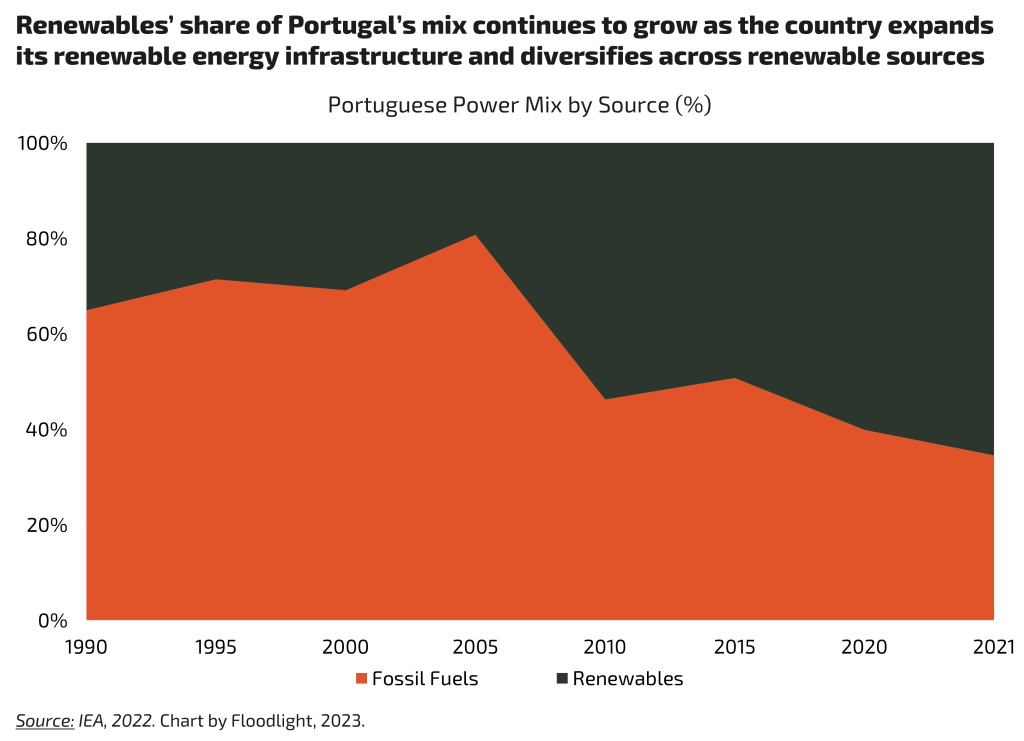Portugal recently experienced a six-day period (149 hours) during which all power generation was completely renewable. Benefitting from favorable weather conditions, the country’s vast clean energy infrastructure produced 1,102 GWh of energy – an excess of 840 GWh versus typical demand. Such a surplus enabled an almost four-day period of energy exports to Spain and, most encouragingly, a more than five-day period of running fully without natural gas.
What enabled this? The share of renewable power in Portugal’s overall power mix accelerated dramatically in recent years. In 2021, more than 65% of all power produced in Portugal was renewable (as of 2021), up 45% from 2005, with 53% of this power coming from wind and hydroelectric sources. These sources tend to generate closer to their capacity in stormy conditions. So, with the right infrastructure in place, Portugal was able to take full advantage. According to Hugo Costa, the Deputy Manger of Portugal for renewable producer EDP Renováveis, “the gas plants were there, waiting to dispatch energy, should it be needed. It was not, because the wind was blowing; it was raining a lot.”

While this speaks volumes to renewable energy’s ability to produce enough power to run a country, it also highlights the variable nature of renewable power generation. Favorable conditions like those experienced in Portugal are neither the norm, nor frequent enough to enable the phasing out of fossil fuels by wind or hydroelectric power alone. But this is not to say a full transition to renewable energy is unviable – quite the opposite, actually.
Diversifying energy sources is a key facet of the clean energy transition. Solar photovoltaic (PV) power, for instance, serves as a perfect complement to wind power, typically producing more power in clear conditions when wind turbines might be performing sub-optimally. Transition-focused countries like Portugal are rapidly expanding their solar deployments with this in mind. Speaking to this, Portugal generated 732x more solar power in 2021 than in 2005. It also boasts Europe’s largest floating solar farm. The installation is made up of 12,000 different panels and is located in a hydroelectric plant, also highlighting the dynamic characteristics of many renewable sources.
Portugal is one of the many EU countries leading the charge on achieving the bloc’s 2050 carbon neutrality goal. With more energy coming from renewable sources, Portugal was able to close its last Portuguese coal plant in 2021. As the country continues to grow and diversify its renewable energy infrastructure, it aims to close down its last natural gas plant by 2040. Other countries can look to Portugal for a totem of a prudent phasing-out of fossil fuels. And they can turn to Floodlight’s satellite measurements to verify the positive environmental impacts that come as a result of such changes.
Sources:
1. Large, Holly. “Portugal Just Ran on Entirely Renewable Energy for a Record-Breaking 6 Consecutive Days.” IFLScience, IFLScience, 20 Nov. 2023, www.iflscience.com/portugal-just-ran-on-entirely-renewable-energy-for-a-record-breaking-6-consecutive-days-71643.
3. “Portugal Builds Europe’s Largest Floating Solar Park.” YouTube, YouTube, 9 May 2022, https://www.youtube.com/watch?v=V8AkaZ3PSMk&t=5s. Accessed 1 Dec. 2023.
4. Portugal Just Ran on 100% Renewable Energy for Six Days in a Row – UNILAD, www.unilad.com/news/world-news/portugal-renewable-energy-six-days-straight-622623-20231119. Accessed 1 Dec. 2023.
5. Countries: Portugal. IEA, IEA, June 2022, https://www.iea.org/countries/portugal. Accessed 4 Dec 2023.
Image: Horacio Villalobos#Corbis/Corbis via Getty Images

